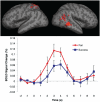The posterior superior temporal sulcus is sensitive to the outcome of human and non-human goal-directed actions
- PMID: 21097958
- PMCID: PMC3190213
- DOI: 10.1093/scan/nsq087
The posterior superior temporal sulcus is sensitive to the outcome of human and non-human goal-directed actions
Abstract
Prior studies have demonstrated that the posterior superior temporal sulcus (pSTS) is involved in analyzing the intentions underlying actions and is sensitive to the context within which actions occur. However, it is debated whether the pSTS is actually sensitive to goals underlying actions, or whether previous studies can be interpreted to suggest that the pSTS is instead involved in the allocation of visual attention towards unexpected events. In addition, little is known about whether the pSTS is specialized for reasoning about the actions of social agents or whether the pSTS is sensitive to the actions of both animate and inanimate entities. Here, using functional magnetic resonance imaging, we investigated activation in response to passive viewing of successful and unsuccessful animate and inanimate goal-directed actions. Activation in the right pSTS was stronger in response to failed actions compared to successful actions, suggesting that the pSTS plays a role in encoding the goals underlying actions. Activation in the pSTS did not differentiate between animate and inanimate actions, suggesting that the pSTS is sensitive to the goal-directed actions of both animate and inanimate entities.
Figures




Similar articles
-
Attributing intentions to random motion engages the posterior superior temporal sulcus.Soc Cogn Affect Neurosci. 2014 Jan;9(1):81-7. doi: 10.1093/scan/nss110. Epub 2012 Sep 14. Soc Cogn Affect Neurosci. 2014. PMID: 22983598 Free PMC article.
-
Activation in posterior superior temporal sulcus parallels parameter inducing the percept of animacy.Neuron. 2005 Feb 17;45(4):625-35. doi: 10.1016/j.neuron.2004.12.052. Neuron. 2005. PMID: 15721247
-
Enhanced activation in the extrastriate body area by goal-directed actions.Psychiatry Clin Neurosci. 2008 Apr;62(2):214-9. doi: 10.1111/j.1440-1819.2008.01757.x. Psychiatry Clin Neurosci. 2008. PMID: 18412845
-
Regional brain activation evoked when approaching a virtual human on a virtual walk.J Cogn Neurosci. 2005 Nov;17(11):1744-52. doi: 10.1162/089892905774589253. J Cogn Neurosci. 2005. PMID: 16269110
-
Dissociating the detection of intentionality from animacy in the right posterior superior temporal sulcus.J Neurosci. 2012 Oct 10;32(41):14276-80. doi: 10.1523/JNEUROSCI.0562-12.2012. J Neurosci. 2012. PMID: 23055497 Free PMC article. Clinical Trial.
Cited by
-
Distributed network flows generate localized category selectivity in human visual cortex.PLoS Comput Biol. 2024 Oct 22;20(10):e1012507. doi: 10.1371/journal.pcbi.1012507. eCollection 2024 Oct. PLoS Comput Biol. 2024. PMID: 39436929 Free PMC article.
-
Probabilistic atlases for face and biological motion perception: an analysis of their reliability and overlap.Neuroimage. 2013 Jul 1;74:140-51. doi: 10.1016/j.neuroimage.2013.02.025. Epub 2013 Feb 20. Neuroimage. 2013. PMID: 23435213 Free PMC article.
-
How Do Object Shape, Semantic Cues, and Apparent Velocity Affect the Attribution of Intentionality to Figures With Different Types of Movements?Front Psychol. 2020 May 15;11:935. doi: 10.3389/fpsyg.2020.00935. eCollection 2020. Front Psychol. 2020. PMID: 32477225 Free PMC article.
-
Theory of mind: a neural prediction problem.Neuron. 2013 Sep 4;79(5):836-48. doi: 10.1016/j.neuron.2013.08.020. Neuron. 2013. PMID: 24012000 Free PMC article. Review.
-
Social closeness modulates brain dynamics during trust anticipation.Sci Rep. 2022 Sep 29;12(1):16337. doi: 10.1038/s41598-022-20827-y. Sci Rep. 2022. PMID: 36175533 Free PMC article.
References
-
- Aleong R, Paus T. Neural correlates of human body perception. Journal of Cognitive Neuroscience. 2010;22:482–95. - PubMed
-
- Allison T, Puce A, McCarthy G. Social perception from visual cues: role of the STS region. Trends in Cognitive Sciences. 2000;4:267–78. - PubMed
-
- Beauchamp MS, Lee KE, Haxby JV, Martin A. fMRI responses to video and point-light displays of moving humans and manipulable objects. Journal of Cognitive Neuroscience. 2003;15:991–1001. - PubMed
-
- Beckmann CF, Jenkinson M, Smith SM. General multilevel linear modeling for group analysis in fMRI. NeuroImage. 2003;20:1052–63. - PubMed
-
- Biro S, Csibra G, Gergely G. The role of behavioral cues in understanding goal-directed actions in infancy. Progress in Brain Research. 2007;164:303–23. - PubMed

